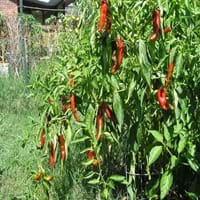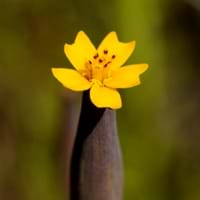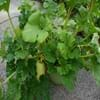Life Span
Perennial
Annual
Type
Vegetable
Flowering Plants
Origin
Mexico, Central America, South America
Mexico, Central America, South America
Types
Poblano, Thai pepper, Cayenne pepper
Not available
Number of Varieties
Not Available
Habitat
Cultivated Beds
Cultivated Beds
USDA Hardiness Zone
10-11
8-11
AHS Heat Zone
12-1
12 - 1
Sunset Zone
A1, A2, A3, H1, H2, 1a, 1b, 2a, 2b, 3a, 3b, 4, 5, 6, 7, 8, 9, 10, 11, 12, 13, 14, 15, 16, 17, 18, 19, 20, 21, 22, 23, 24
A1, A2, A3, H1, H2, 1a, 1b, 2a, 2b, 3a, 3b, 4, 5, 6, 7, 8, 9, 10, 11, 12, 13, 14, 15, 16, 17, 18, 19, 20, 21, 22, 23, 24
Habit
Oval or Rounded
Cushion/Mound-forming
Flower Color
White
Yellow, Orange, Gold, Orange Red
Flower Color Modifier
Bicolor
Bicolor
Fruit Color
Red, Green, Crimson
Not Available
Leaf Color in Spring
Pale Green
Green
Leaf Color in Summer
Green
Green
Leaf Color in Fall
Green, Black
Green
Leaf Color in Winter
Green
Light Green
Leaf Shape
Cordate
Pinnate
Plant Season
Spring, Summer, Fall
Spring, Summer, Fall
Sunlight
Full Sun
Full Sun, Partial Sun
Type of Soil
Loam
Loam, Sand
The pH of Soil
Neutral
Acidic, Neutral
Soil Drainage
Well drained
Well drained
Bloom Time
Indeterminate
Indeterminate
Tolerances
Drought
Drought
Where to Plant?
Container, Ground, Pot
Ground
How to Plant?
Seedlings
Divison, Layering, Stem Cutting
Plant Maintenance
Medium
Medium
Watering Requirements
Requires regular watering
Requires regular watering
In Summer
Lots of watering
Lots of watering
In Spring
Moderate
Moderate
In Winter
Average Water
Average Water
Soil pH
Neutral
Slightly Acidic
Soil Drainage Capacity
Well drained
Well drained
Sun Exposure
Full Sun
Part sun
Pruning
Remove damaged leaves, Remove dead branches, Remove dead leaves
Remove damaged leaves, Remove dead branches, Remove dead leaves
Fertilizers
Balanced organic fertilizer
All-Purpose Liquid Fertilizer
Pests and Diseases
Anthracnose, Aphids, Bacterial leaf spot, Bacterial soft rot
Red blotch
Plant Tolerance
Drought
Drought
Flowers
Insignificant
Showy
Flower Petal Number
Single
Single
Fragrant Bark/Stem
No
Yes
Foliage Texture
Medium
Fine
Foliage Sheen
Glossy
Matte
Attracts
Beetles, Bugs, Insects
Butterflies
Allergy
Rash, Swelling
Not Available
Aesthetic Uses
Not Used For Aesthetic Purpose
Beautification, Decorating walls, Hanging Basket, Showy Purposes, Used as an interior landscaping species
Beauty Benefits
Not Available
Not Available
Environmental Uses
Air purification
Air purification, Food for birds
Medicinal Uses
Antidiarrhoeal, Antiemetic, Antirheumatic, Antispasmodic, Appetizer, Digestive
Cancer, Diarrhea, Hepatitis, Inflammation, Wounds
Part of Plant Used
Flowers, Fruits, Leaves
Flowers
Other Uses
Used as a potherb, Used as colouring in foods, Used in curries, soups, stews
Air freshner, Condiment, For making oil for cosmetics, Garland, Making Sweet Scented Oil, Medicinal oil, Used as an ointment, Used as Ornamental plant, Used for fragrance, Used for its medicinal properties, Used for Landscaping
Used As Indoor Plant
Yes
Insignificant
Used As Outdoor Plant
Yes
Yes
Garden Design
Container, Edible, Herb / Vegetable, Tropical
Dried Flower, Landscape, Lawns and Turf
Botanical Name
CAPSICUM annuum 'Boldog Hungarian Spice'
Tagetes subulata
Common Name
Boldog Hungarian Spice Pepper, Paprika Pepper
Tagetes Sabulata
In Hindi
Paprika Pepper
Tagetes subulata
In German
Paprika -Pfeffer
Tagetes Subulata
In French
Paprika Pepper
Tagetes Subulata
In Spanish
Pimentón pimienta
Tagetes Subulata
In Greek
πάπρικα πιπέρι
Tagetes Subulata
In Portuguese
Paprika pimenta
Tagetes Subulata
In Polish
Papryka Papryka
Tagetes Subulata
In Latin
Paprika Pepper
Tagetes Subulata
Phylum
Magnoliophyta
Tracheophyta
Class
Magnoliopsida
Magnoliopsida
Order
Solanales
Asterales
Family
Solanaceae
Asteraceae
Clade
Asterids, Eudicots
Angiosperms, Asterids, Eudicots
Subfamily
Solanoideae
Asteroideae
Number of Species
Not Available
Not Available
Season and Care of Paprika Pepper and Tagetes Subulata
Season and care of Paprika Pepper and Tagetes Subulata is important to know. While considering everything about Paprika Pepper and Tagetes Subulata Care, growing season is an essential factor. Paprika Pepper season is Spring, Summer and Fall and Tagetes Subulata season is Spring, Summer and Fall. The type of soil for Paprika Pepper is Loam and for Tagetes Subulata is Loam, Sand while the PH of soil for Paprika Pepper is Neutral and for Tagetes Subulata is Acidic, Neutral.
Paprika Pepper and Tagetes Subulata Physical Information
Paprika Pepper and Tagetes Subulata physical information is very important for comparison. Paprika Pepper height is 60.00 cm and width 30.00 cm whereas Tagetes Subulata height is 30.50 cm and width 30.50 cm. The color specification of Paprika Pepper and Tagetes Subulata are as follows:
Paprika Pepper flower color: White
Paprika Pepper leaf color: Pale Green
Tagetes Subulata flower color: Yellow, Orange, Gold and Orange Red
- Tagetes Subulata leaf color: Green
Care of Paprika Pepper and Tagetes Subulata
Care of Paprika Pepper and Tagetes Subulata include pruning, fertilizers, watering etc. Paprika Pepper pruning is done Remove damaged leaves, Remove dead branches and Remove dead leaves and Tagetes Subulata pruning is done Remove damaged leaves, Remove dead branches and Remove dead leaves. In summer Paprika Pepper needs Lots of watering and in winter, it needs Average Water. Whereas, in summer Tagetes Subulata needs Lots of watering and in winter, it needs Average Water.





